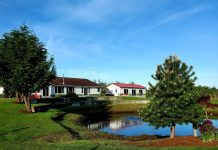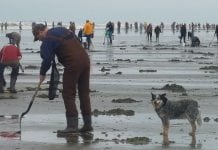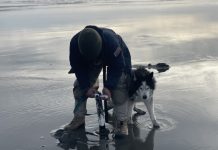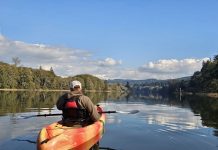This calendar is the place to find fun events happening throughout Grays Harbor County including Aberdeen, Hoquiam, Westport, Ocean Shores, Elma, Montesano and beyond.
Have an event that isn’t listed? Please email events@GraysHarborTalk.com with the following information:
- Name of Event
- Date, time and location (name of business if applicable and complete address)
- Organizer(s) name
- Cost
- URL to purchase tickets
- Website URL
- SHORT description of event
- Photo
Our editors will review and post within a few business days.

Artisan Faire with the theme “Hearts & Flowers… & Chocolate” features NEW Fair Trade gift items from five continents, select PNW vendors and the Patisserie highlighting CHOCOLATE. The Grizzly Den will be offering a catered menu tailored for this two-day event. Artisan Faire Adopt-A-Resident offers individually created gift packages for the residents of Green Lake Assisted Living in Ocean Shores. Adopt one or more of the residents with special Valentine’s gifts and Easter Baskets focused on the Fair Trade and show gift items. Net proceeds benefit Garden by the Sea – a Community Garden where the community grows flowers and produce for the community including beds providing fresh produce for Ocean Shores Food Bank recipients.

Artisan Faire with the theme “Hearts & Flowers… & Chocolate” features NEW Fair Trade gift items from five continents, select PNW vendors and the Patisserie highlighting CHOCOLATE. The Grizzly Den will be offering a catered menu tailored for this two-day event. Artisan Faire Adopt-A-Resident offers individually created gift packages for the residents of Green Lake Assisted Living in Ocean Shores. Adopt one or more of the residents with special Valentine’s gifts and Easter Baskets focused on the Fair Trade and show gift items. Net proceeds benefit Garden by the Sea – a Community Garden where the community grows flowers and produce for the community including beds providing fresh produce for Ocean Shores Food Bank recipients.
Six days of razor clam digging at Mocrocks beaches starts Friday, Feb. 17, Copalis Beach opens Saturday, Feb. 18
OLYMPIA – Washington Department of Fish and Wildlife (WDFW) shellfish managers today confirmed razor clam digging reopens at Mocrocks beaches Friday, Feb. 17 followed by opportunities Feb. 19 and Feb. 21. This is in addition to Copalis Beach open on Saturday, Feb.18, Feb. 20, and Feb. 22.
“The forecast looks good for another six days of razor clam harvest on Copalis and Mocrocks only,” said Bryce Blumenthal, a WDFW coastal shellfish biologist. “That combined with later sunsets and deeper low tides should provide plenty of opportunity for successful digging.”
The following digs during evening (p.m.) low tides will proceed as scheduled:
- Feb. 17, Friday, 4:29 p.m.; -0.7 feet; Mocrocks
- Feb. 18, Saturday, 5:19 p.m.; -1.2 feet; Copalis
- Feb. 19, Sunday, 6:04 p.m.; -1.5 feet; Mocrocks
- Feb. 20, Monday, 6:46 p.m.; -1.4 feet; Copalis
- Feb. 21, Tuesday, 7:26 p.m.; -1.0 feet; Mocrocks
- Feb. 22, Wednesday, 8:05 p.m.; -0.3 feet; Copalis
The Washington Department of Health (WDOH) labs indicate domoic acid levels at Long Beach and Twin Harbors beaches were still above the health guideline levels. WDFW will announce future digging opportunities when marine toxin tests show it is safe to do so.
Domoic acid, a natural toxin produced by certain types of marine algae, can be harmful or fatal if consumed in sufficient quantities. WDFW shellfish staff will continue to regularly dig test samples of razor clams to monitor the situation. WDOH requires two test samples taken around seven days apart, must fall under the health guideline level before a beach can reopen for razor clam digging. More information about domoic acid, as well as current levels at ocean beaches, can be found on WDFW’s domoic acid webpage.
The daily limit is 15 razor clams per person. Under state law, a daily limit consists of the first 15 clams dug regardless of size or condition, and each digger’s clams must be kept in a separate container. Digging is prohibited in the razor clam reserve located just south of the Ocean City approach on Copalis, which are marked by 10-foot poles with signs. The most successful digging occurs between one and two hours before the listed time of low tide.
All diggers age 15 or older must have an applicable fishing license to harvest razor clams on any beach. Licenses may be purchased on WDFW’s licensing website, and from hundreds of license vendors around the state. WDFW recommends buying your license before visiting coastal beach communities.
For additional details, go to the WDFW’s razor clam webpage and the DOH webpage. To be notified of in-season rule changes as they are announced sign up for email notifications at wdfw.wa.gov/about/lists.
The Washington Department of Fish and Wildlife works to preserve, protect, and perpetuate fish, wildlife and ecosystems while providing sustainable fish and wildlife recreational and commercial opportunities.
Six days of razor clam digging at Mocrocks beaches starts Friday, Feb. 17, Copalis Beach opens Saturday, Feb. 18
OLYMPIA – Washington Department of Fish and Wildlife (WDFW) shellfish managers today confirmed razor clam digging reopens at Mocrocks beaches Friday, Feb. 17 followed by opportunities Feb. 19 and Feb. 21. This is in addition to Copalis Beach open on Saturday, Feb.18, Feb. 20, and Feb. 22.
“The forecast looks good for another six days of razor clam harvest on Copalis and Mocrocks only,” said Bryce Blumenthal, a WDFW coastal shellfish biologist. “That combined with later sunsets and deeper low tides should provide plenty of opportunity for successful digging.”
The following digs during evening (p.m.) low tides will proceed as scheduled:
- Feb. 17, Friday, 4:29 p.m.; -0.7 feet; Mocrocks
- Feb. 18, Saturday, 5:19 p.m.; -1.2 feet; Copalis
- Feb. 19, Sunday, 6:04 p.m.; -1.5 feet; Mocrocks
- Feb. 20, Monday, 6:46 p.m.; -1.4 feet; Copalis
- Feb. 21, Tuesday, 7:26 p.m.; -1.0 feet; Mocrocks
- Feb. 22, Wednesday, 8:05 p.m.; -0.3 feet; Copalis
The Washington Department of Health (WDOH) labs indicate domoic acid levels at Long Beach and Twin Harbors beaches were still above the health guideline levels. WDFW will announce future digging opportunities when marine toxin tests show it is safe to do so.
Domoic acid, a natural toxin produced by certain types of marine algae, can be harmful or fatal if consumed in sufficient quantities. WDFW shellfish staff will continue to regularly dig test samples of razor clams to monitor the situation. WDOH requires two test samples taken around seven days apart, must fall under the health guideline level before a beach can reopen for razor clam digging. More information about domoic acid, as well as current levels at ocean beaches, can be found on WDFW’s domoic acid webpage.
The daily limit is 15 razor clams per person. Under state law, a daily limit consists of the first 15 clams dug regardless of size or condition, and each digger’s clams must be kept in a separate container. Digging is prohibited in the razor clam reserve located just south of the Ocean City approach on Copalis, which are marked by 10-foot poles with signs. The most successful digging occurs between one and two hours before the listed time of low tide.
All diggers age 15 or older must have an applicable fishing license to harvest razor clams on any beach. Licenses may be purchased on WDFW’s licensing website, and from hundreds of license vendors around the state. WDFW recommends buying your license before visiting coastal beach communities.
For additional details, go to the WDFW’s razor clam webpage and the DOH webpage. To be notified of in-season rule changes as they are announced sign up for email notifications at wdfw.wa.gov/about/lists.
The Washington Department of Fish and Wildlife works to preserve, protect, and perpetuate fish, wildlife and ecosystems while providing sustainable fish and wildlife recreational and commercial opportunities.
Six days of razor clam digging at Mocrocks beaches starts Friday, Feb. 17, Copalis Beach opens Saturday, Feb. 18
OLYMPIA – Washington Department of Fish and Wildlife (WDFW) shellfish managers today confirmed razor clam digging reopens at Mocrocks beaches Friday, Feb. 17 followed by opportunities Feb. 19 and Feb. 21. This is in addition to Copalis Beach open on Saturday, Feb.18, Feb. 20, and Feb. 22.
“The forecast looks good for another six days of razor clam harvest on Copalis and Mocrocks only,” said Bryce Blumenthal, a WDFW coastal shellfish biologist. “That combined with later sunsets and deeper low tides should provide plenty of opportunity for successful digging.”
The following digs during evening (p.m.) low tides will proceed as scheduled:
- Feb. 17, Friday, 4:29 p.m.; -0.7 feet; Mocrocks
- Feb. 18, Saturday, 5:19 p.m.; -1.2 feet; Copalis
- Feb. 19, Sunday, 6:04 p.m.; -1.5 feet; Mocrocks
- Feb. 20, Monday, 6:46 p.m.; -1.4 feet; Copalis
- Feb. 21, Tuesday, 7:26 p.m.; -1.0 feet; Mocrocks
- Feb. 22, Wednesday, 8:05 p.m.; -0.3 feet; Copalis
The Washington Department of Health (WDOH) labs indicate domoic acid levels at Long Beach and Twin Harbors beaches were still above the health guideline levels. WDFW will announce future digging opportunities when marine toxin tests show it is safe to do so.
Domoic acid, a natural toxin produced by certain types of marine algae, can be harmful or fatal if consumed in sufficient quantities. WDFW shellfish staff will continue to regularly dig test samples of razor clams to monitor the situation. WDOH requires two test samples taken around seven days apart, must fall under the health guideline level before a beach can reopen for razor clam digging. More information about domoic acid, as well as current levels at ocean beaches, can be found on WDFW’s domoic acid webpage.
The daily limit is 15 razor clams per person. Under state law, a daily limit consists of the first 15 clams dug regardless of size or condition, and each digger’s clams must be kept in a separate container. Digging is prohibited in the razor clam reserve located just south of the Ocean City approach on Copalis, which are marked by 10-foot poles with signs. The most successful digging occurs between one and two hours before the listed time of low tide.
All diggers age 15 or older must have an applicable fishing license to harvest razor clams on any beach. Licenses may be purchased on WDFW’s licensing website, and from hundreds of license vendors around the state. WDFW recommends buying your license before visiting coastal beach communities.
For additional details, go to the WDFW’s razor clam webpage and the DOH webpage. To be notified of in-season rule changes as they are announced sign up for email notifications at wdfw.wa.gov/about/lists.
The Washington Department of Fish and Wildlife works to preserve, protect, and perpetuate fish, wildlife and ecosystems while providing sustainable fish and wildlife recreational and commercial opportunities.
Six days of razor clam digging at Mocrocks beaches starts Friday, Feb. 17, Copalis Beach opens Saturday, Feb. 18
OLYMPIA – Washington Department of Fish and Wildlife (WDFW) shellfish managers today confirmed razor clam digging reopens at Mocrocks beaches Friday, Feb. 17 followed by opportunities Feb. 19 and Feb. 21. This is in addition to Copalis Beach open on Saturday, Feb.18, Feb. 20, and Feb. 22.
“The forecast looks good for another six days of razor clam harvest on Copalis and Mocrocks only,” said Bryce Blumenthal, a WDFW coastal shellfish biologist. “That combined with later sunsets and deeper low tides should provide plenty of opportunity for successful digging.”
The following digs during evening (p.m.) low tides will proceed as scheduled:
- Feb. 17, Friday, 4:29 p.m.; -0.7 feet; Mocrocks
- Feb. 18, Saturday, 5:19 p.m.; -1.2 feet; Copalis
- Feb. 19, Sunday, 6:04 p.m.; -1.5 feet; Mocrocks
- Feb. 20, Monday, 6:46 p.m.; -1.4 feet; Copalis
- Feb. 21, Tuesday, 7:26 p.m.; -1.0 feet; Mocrocks
- Feb. 22, Wednesday, 8:05 p.m.; -0.3 feet; Copalis
The Washington Department of Health (WDOH) labs indicate domoic acid levels at Long Beach and Twin Harbors beaches were still above the health guideline levels. WDFW will announce future digging opportunities when marine toxin tests show it is safe to do so.
Domoic acid, a natural toxin produced by certain types of marine algae, can be harmful or fatal if consumed in sufficient quantities. WDFW shellfish staff will continue to regularly dig test samples of razor clams to monitor the situation. WDOH requires two test samples taken around seven days apart, must fall under the health guideline level before a beach can reopen for razor clam digging. More information about domoic acid, as well as current levels at ocean beaches, can be found on WDFW’s domoic acid webpage.
The daily limit is 15 razor clams per person. Under state law, a daily limit consists of the first 15 clams dug regardless of size or condition, and each digger’s clams must be kept in a separate container. Digging is prohibited in the razor clam reserve located just south of the Ocean City approach on Copalis, which are marked by 10-foot poles with signs. The most successful digging occurs between one and two hours before the listed time of low tide.
All diggers age 15 or older must have an applicable fishing license to harvest razor clams on any beach. Licenses may be purchased on WDFW’s licensing website, and from hundreds of license vendors around the state. WDFW recommends buying your license before visiting coastal beach communities.
For additional details, go to the WDFW’s razor clam webpage and the DOH webpage. To be notified of in-season rule changes as they are announced sign up for email notifications at wdfw.wa.gov/about/lists.
The Washington Department of Fish and Wildlife works to preserve, protect, and perpetuate fish, wildlife and ecosystems while providing sustainable fish and wildlife recreational and commercial opportunities.
Six days of razor clam digging at Mocrocks beaches starts Friday, Feb. 17, Copalis Beach opens Saturday, Feb. 18
OLYMPIA – Washington Department of Fish and Wildlife (WDFW) shellfish managers today confirmed razor clam digging reopens at Mocrocks beaches Friday, Feb. 17 followed by opportunities Feb. 19 and Feb. 21. This is in addition to Copalis Beach open on Saturday, Feb.18, Feb. 20, and Feb. 22.
“The forecast looks good for another six days of razor clam harvest on Copalis and Mocrocks only,” said Bryce Blumenthal, a WDFW coastal shellfish biologist. “That combined with later sunsets and deeper low tides should provide plenty of opportunity for successful digging.”
The following digs during evening (p.m.) low tides will proceed as scheduled:
- Feb. 17, Friday, 4:29 p.m.; -0.7 feet; Mocrocks
- Feb. 18, Saturday, 5:19 p.m.; -1.2 feet; Copalis
- Feb. 19, Sunday, 6:04 p.m.; -1.5 feet; Mocrocks
- Feb. 20, Monday, 6:46 p.m.; -1.4 feet; Copalis
- Feb. 21, Tuesday, 7:26 p.m.; -1.0 feet; Mocrocks
- Feb. 22, Wednesday, 8:05 p.m.; -0.3 feet; Copalis
The Washington Department of Health (WDOH) labs indicate domoic acid levels at Long Beach and Twin Harbors beaches were still above the health guideline levels. WDFW will announce future digging opportunities when marine toxin tests show it is safe to do so.
Domoic acid, a natural toxin produced by certain types of marine algae, can be harmful or fatal if consumed in sufficient quantities. WDFW shellfish staff will continue to regularly dig test samples of razor clams to monitor the situation. WDOH requires two test samples taken around seven days apart, must fall under the health guideline level before a beach can reopen for razor clam digging. More information about domoic acid, as well as current levels at ocean beaches, can be found on WDFW’s domoic acid webpage.
The daily limit is 15 razor clams per person. Under state law, a daily limit consists of the first 15 clams dug regardless of size or condition, and each digger’s clams must be kept in a separate container. Digging is prohibited in the razor clam reserve located just south of the Ocean City approach on Copalis, which are marked by 10-foot poles with signs. The most successful digging occurs between one and two hours before the listed time of low tide.
All diggers age 15 or older must have an applicable fishing license to harvest razor clams on any beach. Licenses may be purchased on WDFW’s licensing website, and from hundreds of license vendors around the state. WDFW recommends buying your license before visiting coastal beach communities.
For additional details, go to the WDFW’s razor clam webpage and the DOH webpage. To be notified of in-season rule changes as they are announced sign up for email notifications at wdfw.wa.gov/about/lists.
The Washington Department of Fish and Wildlife works to preserve, protect, and perpetuate fish, wildlife and ecosystems while providing sustainable fish and wildlife recreational and commercial opportunities.
Six days of razor clam digging at Mocrocks beaches starts Friday, Feb. 17, Copalis Beach opens Saturday, Feb. 18
OLYMPIA – Washington Department of Fish and Wildlife (WDFW) shellfish managers today confirmed razor clam digging reopens at Mocrocks beaches Friday, Feb. 17 followed by opportunities Feb. 19 and Feb. 21. This is in addition to Copalis Beach open on Saturday, Feb.18, Feb. 20, and Feb. 22.
“The forecast looks good for another six days of razor clam harvest on Copalis and Mocrocks only,” said Bryce Blumenthal, a WDFW coastal shellfish biologist. “That combined with later sunsets and deeper low tides should provide plenty of opportunity for successful digging.”
The following digs during evening (p.m.) low tides will proceed as scheduled:
- Feb. 17, Friday, 4:29 p.m.; -0.7 feet; Mocrocks
- Feb. 18, Saturday, 5:19 p.m.; -1.2 feet; Copalis
- Feb. 19, Sunday, 6:04 p.m.; -1.5 feet; Mocrocks
- Feb. 20, Monday, 6:46 p.m.; -1.4 feet; Copalis
- Feb. 21, Tuesday, 7:26 p.m.; -1.0 feet; Mocrocks
- Feb. 22, Wednesday, 8:05 p.m.; -0.3 feet; Copalis
The Washington Department of Health (WDOH) labs indicate domoic acid levels at Long Beach and Twin Harbors beaches were still above the health guideline levels. WDFW will announce future digging opportunities when marine toxin tests show it is safe to do so.
Domoic acid, a natural toxin produced by certain types of marine algae, can be harmful or fatal if consumed in sufficient quantities. WDFW shellfish staff will continue to regularly dig test samples of razor clams to monitor the situation. WDOH requires two test samples taken around seven days apart, must fall under the health guideline level before a beach can reopen for razor clam digging. More information about domoic acid, as well as current levels at ocean beaches, can be found on WDFW’s domoic acid webpage.
The daily limit is 15 razor clams per person. Under state law, a daily limit consists of the first 15 clams dug regardless of size or condition, and each digger’s clams must be kept in a separate container. Digging is prohibited in the razor clam reserve located just south of the Ocean City approach on Copalis, which are marked by 10-foot poles with signs. The most successful digging occurs between one and two hours before the listed time of low tide.
All diggers age 15 or older must have an applicable fishing license to harvest razor clams on any beach. Licenses may be purchased on WDFW’s licensing website, and from hundreds of license vendors around the state. WDFW recommends buying your license before visiting coastal beach communities.
For additional details, go to the WDFW’s razor clam webpage and the DOH webpage. To be notified of in-season rule changes as they are announced sign up for email notifications at wdfw.wa.gov/about/lists.
The Washington Department of Fish and Wildlife works to preserve, protect, and perpetuate fish, wildlife and ecosystems while providing sustainable fish and wildlife recreational and commercial opportunities.

James and Rob Slater grew up here in Hoquiam, HHS classes of ‘78 and ‘85 respectively. Both avid readers, James inspired Rob to write. In 2014, Rob published ALL IS SILENCE, Book I in his Deserted Lands bat-virus pandemic universe. His 5th book is out this winter. James, not to be outdone, has finished his trilogy first, recently releasing Book III, MIDWAY – Empire of Deception. Now they’re working together for success in the challenging arena of indie publishing.
Join us as James and Rob share their experiences and read short excerpts from their books. Q&A and book signing to follow.
Coastal razor clam digging at Mocrocks starts Friday, March 3, Copalis also opens Saturday, March 4
OLYMPIA – Washington Department of Fish and Wildlife (WDFW) shellfish managers today confirmed coastal razor clam digging reopens at Mocrocks Friday, March 3 followed by opportunities March 5 and March 7. This is in addition to Copalis open on Saturday, March 4, March 6, and March 8.
“Hopefully the weather will be kind to us for the upcoming six days of harvest on Copalis and Mocrocks only,” said Bryce Blumenthal, a WDFW coastal shellfish biologist. “The low tides will not be as deep as previous digs, but there should be plenty of daylight digging opportunity considering how early they occur.”
The following digs during evening (p.m.) low tides will proceed as scheduled:
- March 3, Friday, 4:31 PM; 0.6 feet; Mocrocks
- March 4, Saturday, 5:09 PM; 0.4 feet; Copalis
- March 5, Sunday, 5:42 PM; 0.2 feet; Mocrocks
- March 6, Monday, 6:13 PM 0.1 feet; Copalis
- March 7, Tuesday, 6:41 PM; 0.3 feet; Mocrocks
- March 8, Wednesday, 7:09 PM; 0.5 feet; Copalis
Details on these and future tentative digs planned on March 17-22 during evening (p.m.) low tides and March 23-26 during morning (a.m.) low tides can be found by going to the WDFW razor clam webpage.
The Washington Department of Health (WDOH) labs indicate domoic acid levels at Long Beach and Twin Harbors beaches remain slightly above the health guideline levels. WDFW will announce future digging opportunities on those beaches when marine toxin tests show it is safe to do so.
Domoic acid, a natural toxin produced by certain types of marine algae, can be harmful or fatal if consumed in sufficient quantities. WDFW shellfish staff will continue to regularly dig test samples of razor clams to monitor the situation. WDOH requires two test samples taken around seven days apart, must fall under the health guideline level before a beach can reopen for razor clam digging. More information about domoic acid, as well as current levels at ocean beaches, can be found on WDFW’s domoic acid webpage.
The daily limit is 15 razor clams per person. Under state law, a daily limit consists of the first 15 clams dug regardless of size or condition, and each digger’s clams must be kept in a separate container. Digging is prohibited in the razor clam reserve located just south of the Ocean City approach on Copalis, which are marked by 10-foot poles with signs. The most successful digging occurs between one and two hours before the listed time of low tide.
Shellfish and seafood enthusiasts can also start making plans to attend the Ocean Shores Razor Clam and Seafood Festival on March 17-19, and the Long Beach Razor Clam Festival on April 8-9. These two long-running events celebrate the unique contribution of razor clams to Washington’s culture and coastal communities.
With the spring fast approaching, Washingtonians should consider purchasing 2023-2024 recreational hunting and fishing licenses, and from hundreds of license vendors around the state. WDFW recommends buying your license before current licenses expire after March 31. All diggers age 15 or older must have an applicable fishing license to harvest razor clams on any beach.
For additional details, go to the WDFW’s razor clam webpage and the DOH webpage. To be notified of in-season rule changes as they are announced sign up for email notifications at wdfw.wa.gov/about/lists.
The Washington Department of Fish and Wildlife works to preserve, protect, and perpetuate fish, wildlife and ecosystems while providing sustainable fish and wildlife recreational and commercial opportunities.
Coastal razor clam digging at Mocrocks starts Friday, March 3, Copalis also opens Saturday, March 4
OLYMPIA – Washington Department of Fish and Wildlife (WDFW) shellfish managers today confirmed coastal razor clam digging reopens at Mocrocks Friday, March 3 followed by opportunities March 5 and March 7. This is in addition to Copalis open on Saturday, March 4, March 6, and March 8.
“Hopefully the weather will be kind to us for the upcoming six days of harvest on Copalis and Mocrocks only,” said Bryce Blumenthal, a WDFW coastal shellfish biologist. “The low tides will not be as deep as previous digs, but there should be plenty of daylight digging opportunity considering how early they occur.”
The following digs during evening (p.m.) low tides will proceed as scheduled:
- March 3, Friday, 4:31 PM; 0.6 feet; Mocrocks
- March 4, Saturday, 5:09 PM; 0.4 feet; Copalis
- March 5, Sunday, 5:42 PM; 0.2 feet; Mocrocks
- March 6, Monday, 6:13 PM 0.1 feet; Copalis
- March 7, Tuesday, 6:41 PM; 0.3 feet; Mocrocks
- March 8, Wednesday, 7:09 PM; 0.5 feet; Copalis
Details on these and future tentative digs planned on March 17-22 during evening (p.m.) low tides and March 23-26 during morning (a.m.) low tides can be found by going to the WDFW razor clam webpage.
The Washington Department of Health (WDOH) labs indicate domoic acid levels at Long Beach and Twin Harbors beaches remain slightly above the health guideline levels. WDFW will announce future digging opportunities on those beaches when marine toxin tests show it is safe to do so.
Domoic acid, a natural toxin produced by certain types of marine algae, can be harmful or fatal if consumed in sufficient quantities. WDFW shellfish staff will continue to regularly dig test samples of razor clams to monitor the situation. WDOH requires two test samples taken around seven days apart, must fall under the health guideline level before a beach can reopen for razor clam digging. More information about domoic acid, as well as current levels at ocean beaches, can be found on WDFW’s domoic acid webpage.
The daily limit is 15 razor clams per person. Under state law, a daily limit consists of the first 15 clams dug regardless of size or condition, and each digger’s clams must be kept in a separate container. Digging is prohibited in the razor clam reserve located just south of the Ocean City approach on Copalis, which are marked by 10-foot poles with signs. The most successful digging occurs between one and two hours before the listed time of low tide.
Shellfish and seafood enthusiasts can also start making plans to attend the Ocean Shores Razor Clam and Seafood Festival on March 17-19, and the Long Beach Razor Clam Festival on April 8-9. These two long-running events celebrate the unique contribution of razor clams to Washington’s culture and coastal communities.
With the spring fast approaching, Washingtonians should consider purchasing 2023-2024 recreational hunting and fishing licenses, and from hundreds of license vendors around the state. WDFW recommends buying your license before current licenses expire after March 31. All diggers age 15 or older must have an applicable fishing license to harvest razor clams on any beach.
For additional details, go to the WDFW’s razor clam webpage and the DOH webpage. To be notified of in-season rule changes as they are announced sign up for email notifications at wdfw.wa.gov/about/lists.
The Washington Department of Fish and Wildlife works to preserve, protect, and perpetuate fish, wildlife and ecosystems while providing sustainable fish and wildlife recreational and commercial opportunities.
Coastal razor clam digging at Mocrocks starts Friday, March 3, Copalis also opens Saturday, March 4
OLYMPIA – Washington Department of Fish and Wildlife (WDFW) shellfish managers today confirmed coastal razor clam digging reopens at Mocrocks Friday, March 3 followed by opportunities March 5 and March 7. This is in addition to Copalis open on Saturday, March 4, March 6, and March 8.
“Hopefully the weather will be kind to us for the upcoming six days of harvest on Copalis and Mocrocks only,” said Bryce Blumenthal, a WDFW coastal shellfish biologist. “The low tides will not be as deep as previous digs, but there should be plenty of daylight digging opportunity considering how early they occur.”
The following digs during evening (p.m.) low tides will proceed as scheduled:
- March 3, Friday, 4:31 PM; 0.6 feet; Mocrocks
- March 4, Saturday, 5:09 PM; 0.4 feet; Copalis
- March 5, Sunday, 5:42 PM; 0.2 feet; Mocrocks
- March 6, Monday, 6:13 PM 0.1 feet; Copalis
- March 7, Tuesday, 6:41 PM; 0.3 feet; Mocrocks
- March 8, Wednesday, 7:09 PM; 0.5 feet; Copalis
Details on these and future tentative digs planned on March 17-22 during evening (p.m.) low tides and March 23-26 during morning (a.m.) low tides can be found by going to the WDFW razor clam webpage.
The Washington Department of Health (WDOH) labs indicate domoic acid levels at Long Beach and Twin Harbors beaches remain slightly above the health guideline levels. WDFW will announce future digging opportunities on those beaches when marine toxin tests show it is safe to do so.
Domoic acid, a natural toxin produced by certain types of marine algae, can be harmful or fatal if consumed in sufficient quantities. WDFW shellfish staff will continue to regularly dig test samples of razor clams to monitor the situation. WDOH requires two test samples taken around seven days apart, must fall under the health guideline level before a beach can reopen for razor clam digging. More information about domoic acid, as well as current levels at ocean beaches, can be found on WDFW’s domoic acid webpage.
The daily limit is 15 razor clams per person. Under state law, a daily limit consists of the first 15 clams dug regardless of size or condition, and each digger’s clams must be kept in a separate container. Digging is prohibited in the razor clam reserve located just south of the Ocean City approach on Copalis, which are marked by 10-foot poles with signs. The most successful digging occurs between one and two hours before the listed time of low tide.
Shellfish and seafood enthusiasts can also start making plans to attend the Ocean Shores Razor Clam and Seafood Festival on March 17-19, and the Long Beach Razor Clam Festival on April 8-9. These two long-running events celebrate the unique contribution of razor clams to Washington’s culture and coastal communities.
With the spring fast approaching, Washingtonians should consider purchasing 2023-2024 recreational hunting and fishing licenses, and from hundreds of license vendors around the state. WDFW recommends buying your license before current licenses expire after March 31. All diggers age 15 or older must have an applicable fishing license to harvest razor clams on any beach.
For additional details, go to the WDFW’s razor clam webpage and the DOH webpage. To be notified of in-season rule changes as they are announced sign up for email notifications at wdfw.wa.gov/about/lists.
The Washington Department of Fish and Wildlife works to preserve, protect, and perpetuate fish, wildlife and ecosystems while providing sustainable fish and wildlife recreational and commercial opportunities.
Coastal razor clam digging at Mocrocks starts Friday, March 3, Copalis also opens Saturday, March 4
OLYMPIA – Washington Department of Fish and Wildlife (WDFW) shellfish managers today confirmed coastal razor clam digging reopens at Mocrocks Friday, March 3 followed by opportunities March 5 and March 7. This is in addition to Copalis open on Saturday, March 4, March 6, and March 8.
“Hopefully the weather will be kind to us for the upcoming six days of harvest on Copalis and Mocrocks only,” said Bryce Blumenthal, a WDFW coastal shellfish biologist. “The low tides will not be as deep as previous digs, but there should be plenty of daylight digging opportunity considering how early they occur.”
The following digs during evening (p.m.) low tides will proceed as scheduled:
- March 3, Friday, 4:31 PM; 0.6 feet; Mocrocks
- March 4, Saturday, 5:09 PM; 0.4 feet; Copalis
- March 5, Sunday, 5:42 PM; 0.2 feet; Mocrocks
- March 6, Monday, 6:13 PM 0.1 feet; Copalis
- March 7, Tuesday, 6:41 PM; 0.3 feet; Mocrocks
- March 8, Wednesday, 7:09 PM; 0.5 feet; Copalis
Details on these and future tentative digs planned on March 17-22 during evening (p.m.) low tides and March 23-26 during morning (a.m.) low tides can be found by going to the WDFW razor clam webpage.
The Washington Department of Health (WDOH) labs indicate domoic acid levels at Long Beach and Twin Harbors beaches remain slightly above the health guideline levels. WDFW will announce future digging opportunities on those beaches when marine toxin tests show it is safe to do so.
Domoic acid, a natural toxin produced by certain types of marine algae, can be harmful or fatal if consumed in sufficient quantities. WDFW shellfish staff will continue to regularly dig test samples of razor clams to monitor the situation. WDOH requires two test samples taken around seven days apart, must fall under the health guideline level before a beach can reopen for razor clam digging. More information about domoic acid, as well as current levels at ocean beaches, can be found on WDFW’s domoic acid webpage.
The daily limit is 15 razor clams per person. Under state law, a daily limit consists of the first 15 clams dug regardless of size or condition, and each digger’s clams must be kept in a separate container. Digging is prohibited in the razor clam reserve located just south of the Ocean City approach on Copalis, which are marked by 10-foot poles with signs. The most successful digging occurs between one and two hours before the listed time of low tide.
Shellfish and seafood enthusiasts can also start making plans to attend the Ocean Shores Razor Clam and Seafood Festival on March 17-19, and the Long Beach Razor Clam Festival on April 8-9. These two long-running events celebrate the unique contribution of razor clams to Washington’s culture and coastal communities.
With the spring fast approaching, Washingtonians should consider purchasing 2023-2024 recreational hunting and fishing licenses, and from hundreds of license vendors around the state. WDFW recommends buying your license before current licenses expire after March 31. All diggers age 15 or older must have an applicable fishing license to harvest razor clams on any beach.
For additional details, go to the WDFW’s razor clam webpage and the DOH webpage. To be notified of in-season rule changes as they are announced sign up for email notifications at wdfw.wa.gov/about/lists.
The Washington Department of Fish and Wildlife works to preserve, protect, and perpetuate fish, wildlife and ecosystems while providing sustainable fish and wildlife recreational and commercial opportunities.
Coastal razor clam digging at Mocrocks starts Friday, March 3, Copalis also opens Saturday, March 4
OLYMPIA – Washington Department of Fish and Wildlife (WDFW) shellfish managers today confirmed coastal razor clam digging reopens at Mocrocks Friday, March 3 followed by opportunities March 5 and March 7. This is in addition to Copalis open on Saturday, March 4, March 6, and March 8.
“Hopefully the weather will be kind to us for the upcoming six days of harvest on Copalis and Mocrocks only,” said Bryce Blumenthal, a WDFW coastal shellfish biologist. “The low tides will not be as deep as previous digs, but there should be plenty of daylight digging opportunity considering how early they occur.”
The following digs during evening (p.m.) low tides will proceed as scheduled:
- March 3, Friday, 4:31 PM; 0.6 feet; Mocrocks
- March 4, Saturday, 5:09 PM; 0.4 feet; Copalis
- March 5, Sunday, 5:42 PM; 0.2 feet; Mocrocks
- March 6, Monday, 6:13 PM 0.1 feet; Copalis
- March 7, Tuesday, 6:41 PM; 0.3 feet; Mocrocks
- March 8, Wednesday, 7:09 PM; 0.5 feet; Copalis
Details on these and future tentative digs planned on March 17-22 during evening (p.m.) low tides and March 23-26 during morning (a.m.) low tides can be found by going to the WDFW razor clam webpage.
The Washington Department of Health (WDOH) labs indicate domoic acid levels at Long Beach and Twin Harbors beaches remain slightly above the health guideline levels. WDFW will announce future digging opportunities on those beaches when marine toxin tests show it is safe to do so.
Domoic acid, a natural toxin produced by certain types of marine algae, can be harmful or fatal if consumed in sufficient quantities. WDFW shellfish staff will continue to regularly dig test samples of razor clams to monitor the situation. WDOH requires two test samples taken around seven days apart, must fall under the health guideline level before a beach can reopen for razor clam digging. More information about domoic acid, as well as current levels at ocean beaches, can be found on WDFW’s domoic acid webpage.
The daily limit is 15 razor clams per person. Under state law, a daily limit consists of the first 15 clams dug regardless of size or condition, and each digger’s clams must be kept in a separate container. Digging is prohibited in the razor clam reserve located just south of the Ocean City approach on Copalis, which are marked by 10-foot poles with signs. The most successful digging occurs between one and two hours before the listed time of low tide.
Shellfish and seafood enthusiasts can also start making plans to attend the Ocean Shores Razor Clam and Seafood Festival on March 17-19, and the Long Beach Razor Clam Festival on April 8-9. These two long-running events celebrate the unique contribution of razor clams to Washington’s culture and coastal communities.
With the spring fast approaching, Washingtonians should consider purchasing 2023-2024 recreational hunting and fishing licenses, and from hundreds of license vendors around the state. WDFW recommends buying your license before current licenses expire after March 31. All diggers age 15 or older must have an applicable fishing license to harvest razor clams on any beach.
For additional details, go to the WDFW’s razor clam webpage and the DOH webpage. To be notified of in-season rule changes as they are announced sign up for email notifications at wdfw.wa.gov/about/lists.
The Washington Department of Fish and Wildlife works to preserve, protect, and perpetuate fish, wildlife and ecosystems while providing sustainable fish and wildlife recreational and commercial opportunities.
Coastal razor clam digging at Mocrocks starts Friday, March 3, Copalis also opens Saturday, March 4
OLYMPIA – Washington Department of Fish and Wildlife (WDFW) shellfish managers today confirmed coastal razor clam digging reopens at Mocrocks Friday, March 3 followed by opportunities March 5 and March 7. This is in addition to Copalis open on Saturday, March 4, March 6, and March 8.
“Hopefully the weather will be kind to us for the upcoming six days of harvest on Copalis and Mocrocks only,” said Bryce Blumenthal, a WDFW coastal shellfish biologist. “The low tides will not be as deep as previous digs, but there should be plenty of daylight digging opportunity considering how early they occur.”
The following digs during evening (p.m.) low tides will proceed as scheduled:
- March 3, Friday, 4:31 PM; 0.6 feet; Mocrocks
- March 4, Saturday, 5:09 PM; 0.4 feet; Copalis
- March 5, Sunday, 5:42 PM; 0.2 feet; Mocrocks
- March 6, Monday, 6:13 PM 0.1 feet; Copalis
- March 7, Tuesday, 6:41 PM; 0.3 feet; Mocrocks
- March 8, Wednesday, 7:09 PM; 0.5 feet; Copalis
Details on these and future tentative digs planned on March 17-22 during evening (p.m.) low tides and March 23-26 during morning (a.m.) low tides can be found by going to the WDFW razor clam webpage.
The Washington Department of Health (WDOH) labs indicate domoic acid levels at Long Beach and Twin Harbors beaches remain slightly above the health guideline levels. WDFW will announce future digging opportunities on those beaches when marine toxin tests show it is safe to do so.
Domoic acid, a natural toxin produced by certain types of marine algae, can be harmful or fatal if consumed in sufficient quantities. WDFW shellfish staff will continue to regularly dig test samples of razor clams to monitor the situation. WDOH requires two test samples taken around seven days apart, must fall under the health guideline level before a beach can reopen for razor clam digging. More information about domoic acid, as well as current levels at ocean beaches, can be found on WDFW’s domoic acid webpage.
The daily limit is 15 razor clams per person. Under state law, a daily limit consists of the first 15 clams dug regardless of size or condition, and each digger’s clams must be kept in a separate container. Digging is prohibited in the razor clam reserve located just south of the Ocean City approach on Copalis, which are marked by 10-foot poles with signs. The most successful digging occurs between one and two hours before the listed time of low tide.
Shellfish and seafood enthusiasts can also start making plans to attend the Ocean Shores Razor Clam and Seafood Festival on March 17-19, and the Long Beach Razor Clam Festival on April 8-9. These two long-running events celebrate the unique contribution of razor clams to Washington’s culture and coastal communities.
With the spring fast approaching, Washingtonians should consider purchasing 2023-2024 recreational hunting and fishing licenses, and from hundreds of license vendors around the state. WDFW recommends buying your license before current licenses expire after March 31. All diggers age 15 or older must have an applicable fishing license to harvest razor clams on any beach.
For additional details, go to the WDFW’s razor clam webpage and the DOH webpage. To be notified of in-season rule changes as they are announced sign up for email notifications at wdfw.wa.gov/about/lists.
The Washington Department of Fish and Wildlife works to preserve, protect, and perpetuate fish, wildlife and ecosystems while providing sustainable fish and wildlife recreational and commercial opportunities.










































